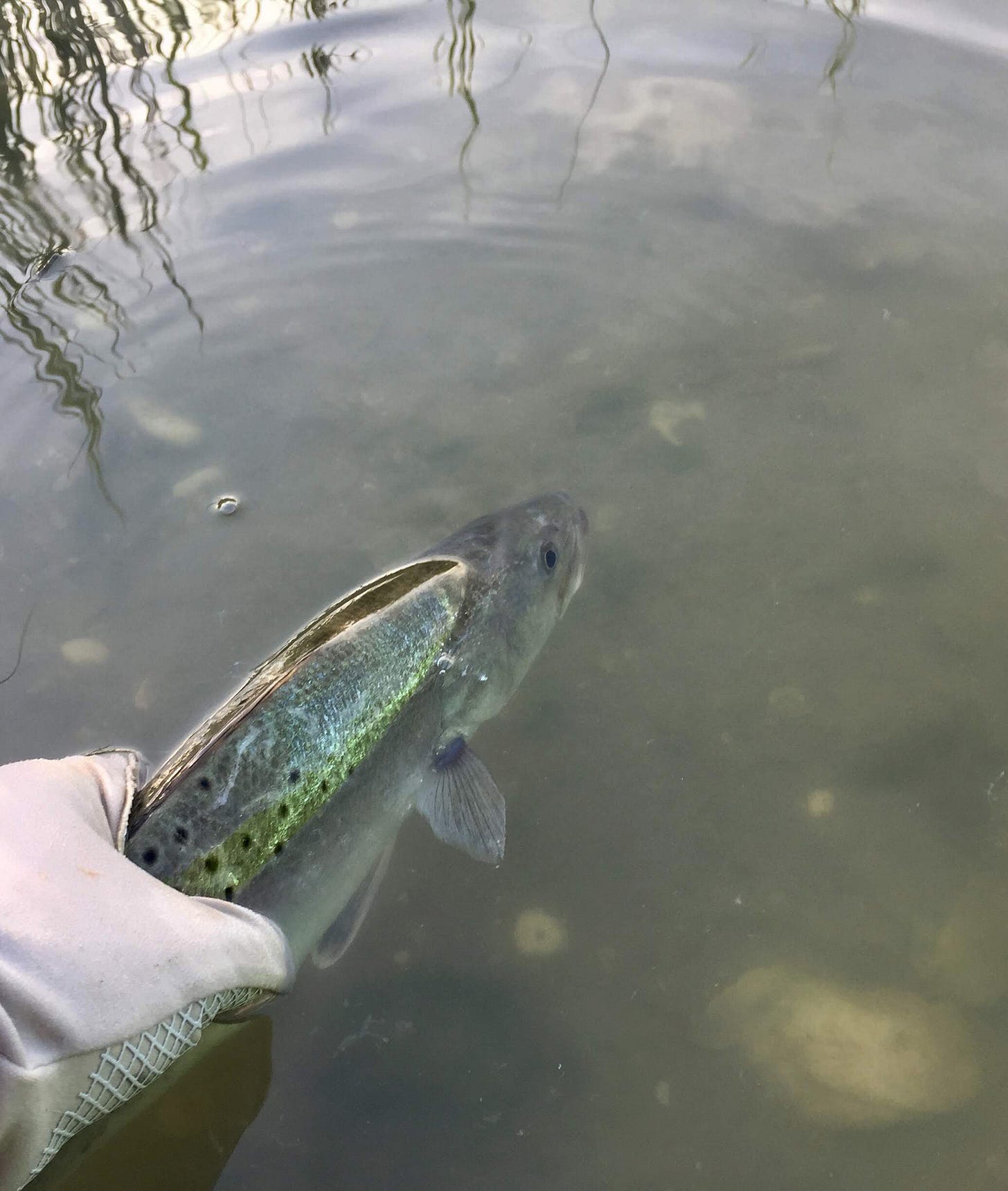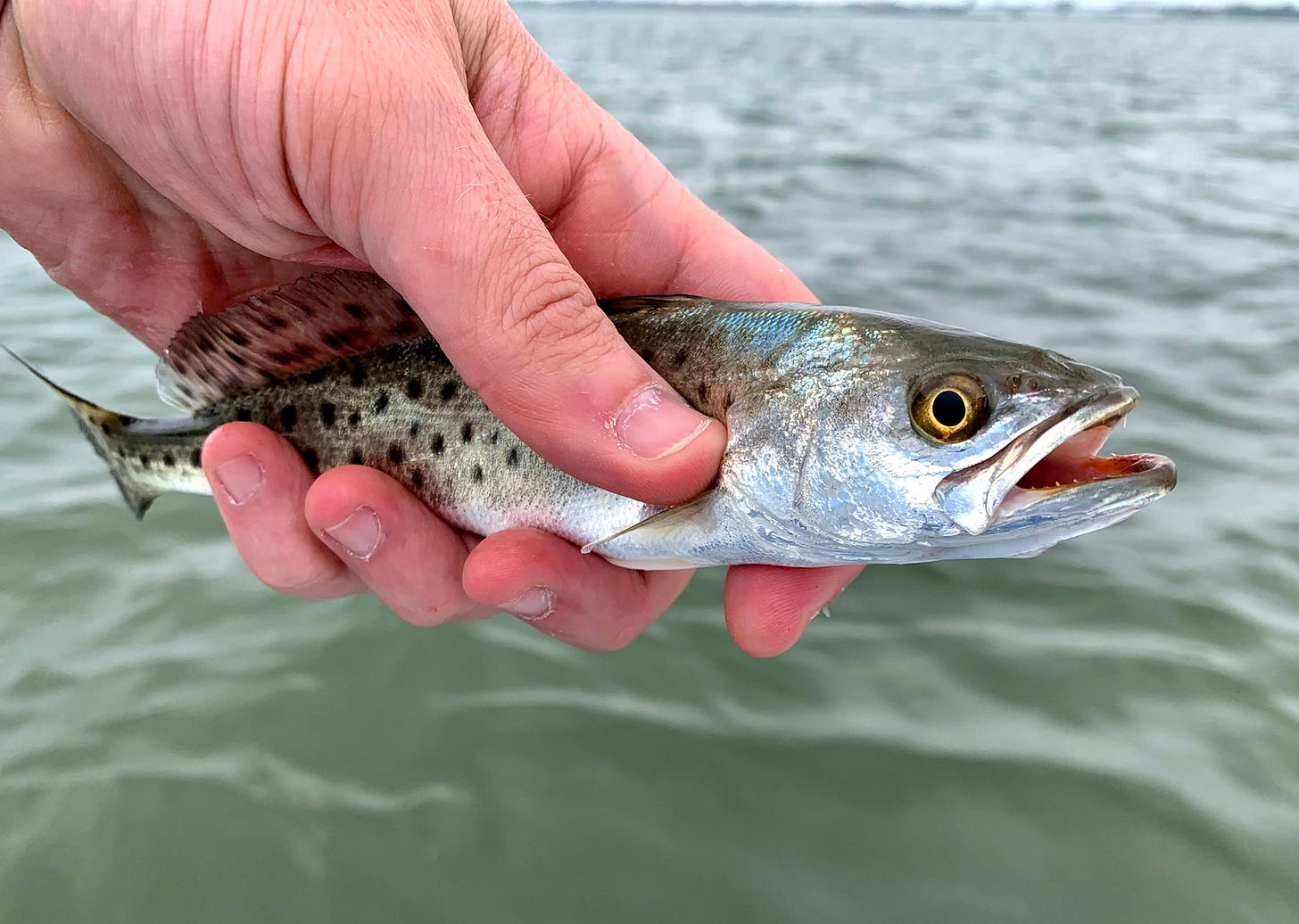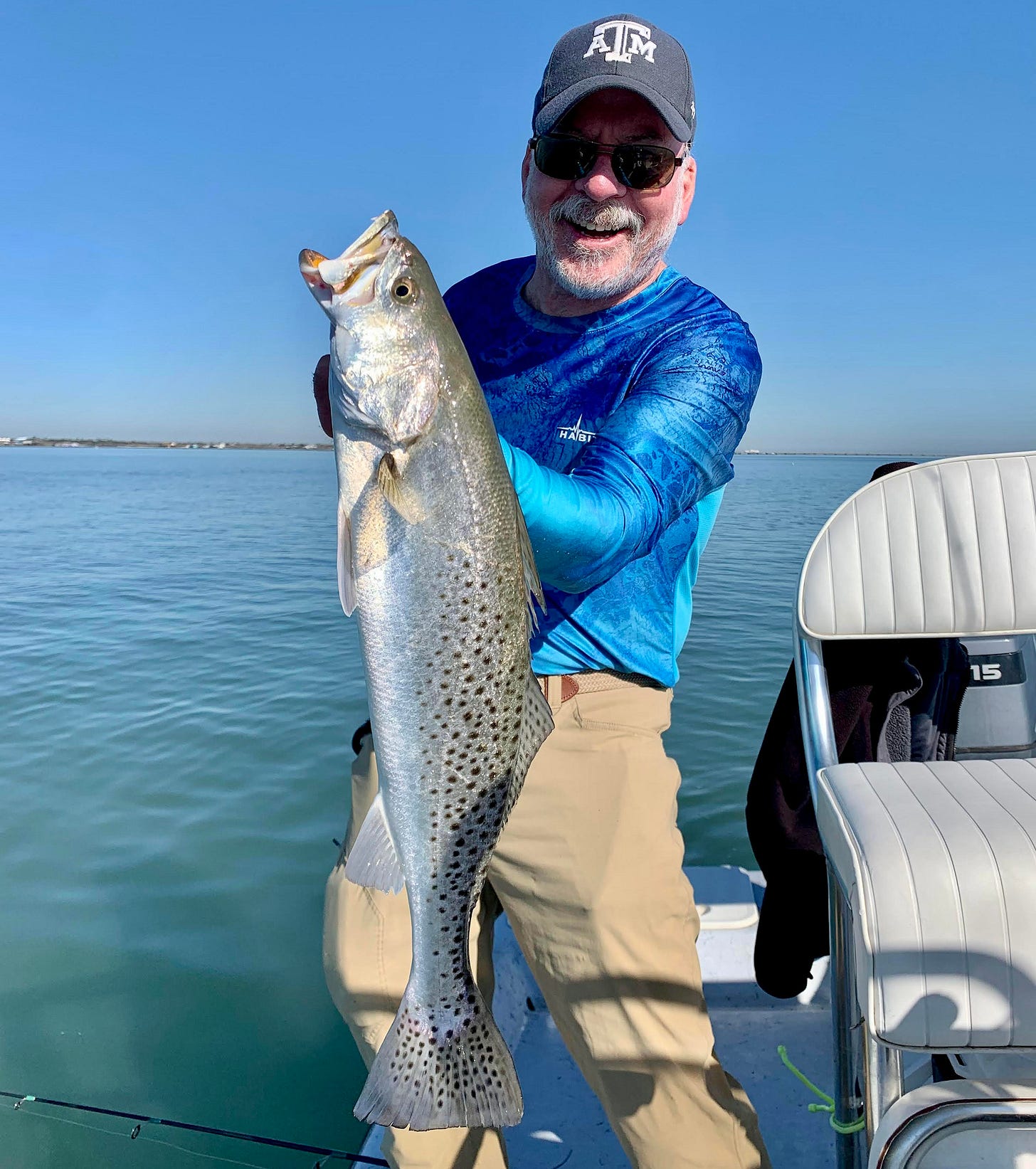Texas speckled trout fishery faces uncertain future amid conservation measures
In February 2021, Texans who live along the coast faced uncertainty that comes with a historic weather event in the form of Winter Storm Uri, which heavily impacted the trout fishery moving forward
Redfish may fight harder.
Flounder may taste better.
And black drum may be every man’s fish.
However, for inshore saltwater fishing die-hards and even the average weekend angler, the speckled trout in Texas is hands down the game fish of choice along the coast year-round.
Whether it’s flipping free-lined live shrimp in the summer along sloping flats lined with sea grass or lobbing a hefty topwater plug in the dead of winter to find large females aggressively feeding before the spawn, the speck is a mainstay in almost every angler’s bag when the bite is on.
The story of the Texas speckled trout fishery certainly is one of many ebbs and flows. It’s a history dotted with tales of the “good old days” when anglers who ventured into the back reaches of the Laguna Madre could land untold numbers of 30-inch plus trout all day long and those who ventured onto piers at night anywhere could fill an entire cooler with legal 12-inch fish.
My how times have changed along our 400-mile coastline that stretches from the Mexican border to Louisiana.
In February 2021, we Texans who live along the coast faced the uncertainty that comes with a historic weather event in the form of Winter Storm Uri. While other portions of the state saw detrimental conditions, to say the least, in South Texas it was simply something we’re not used to dealing with. In Corpus Christi, the temperature didn’t get above 8 degrees for more than two days, which had a devastating effect on fish like speckled trout that simply aren’t designed to withstand that type of weather, even if they can get lower in the thermocline.
A historic and damaging Texas freeze
The Texas Parks and Wildlife Commission in January 2022 adopted proposals reducing the speckled trout slot limit and daily bag from the Matagorda Bay system all the way down the coast to the Mexican border, a direct result of fish kills from Uri. The new trout regulations enacted a 17- to 23-inch slot limit with no keeping of oversize fish and changed the daily bag to three fish in the Upper and Lower Laguna Madre, as well as Corpus Christi Bay, Aransas Bay and San Antonio Bay, in addition to Matagorda. The regulations also went into effect 500 yards off the beach into the Gulf of Mexico in those areas.
The previous trout regulations across the coast featured a 15- to 25-inch slot and the ability to keep one fish over 25 inches as part of a five-fish daily bag. In September 2023, the freeze-related slot and bag limit reverted to the previous statewide regs allowing the five-fish daily limit.
Fisheries officials and biologists rely heavily on gillnet surveys to estimate trout populations across multiple bay systems, and the numbers from the post-freeze surveys showed sharp downward trends in almost every bay:
The Lower Laguna Madre was down about 31%
The Upper Laguna Madre was down about 27%
Aransas Bay was down about 10%
San Antonio Bay was down about 34%
Matagorda Bay was down about 44%
Galveston Bay was down about 1%
Sabine Lake was down about 14%
The only bay system that was up was Corpus Christi Bay at about 9% above the 10-year gillnet average. That bay is a deeper system than other bodies of water on the Texas coast and biologists think that aided in more fish moving into those waters during the freeze, causing the rise in that specific figure. Corpus Christi Bay was put in the new regs due to a concern over increased fishing pressure — meaning folks might target the bay more if it wasn’t included, officials noted. TPWD also cited movement of fish between adjoining bay systems and “genetic connectivity that should help restore populations across all of them.”
TPWD looked at multiple slot limit and bag limit combinations before deciding to propose what was adopted post-freeze. The new three-fish bag limit would result in a 6% increase in what biologists call “biomass,” a fancy word for how many more trout will be estimated in the population as a result of the new regs. The 17- to 23-inch slot limit (with no over fish) would result in a 21% increase in trout biomass in the affected areas. Overall, that would be 27% more trout, TPWD estimated.
TPWD fisheries officials also acknowledged larger fish produce more eggs. However, they noted the majority of the spawning biomass is in the 12- to 17-inch range. That would mean the largest number of reproductively mature fish is in that length size and the new regulations would ease pressure on that “cohort” of fish.
TPWD noted the 2021 freeze wasn’t on par with the major fish-killing freezes in 1983 and 1989 when parts of some bays actually froze and that, on average, it took two to three years for the catch rates of speckled trout to bounce back after those “benchmark events.” However, it should be noted there also were fewer fishing guides and less fishing pressure at that time across the entirety of Texas’ bay framework.
In direct correlation to the 2021 spring gillnet surveys as referenced previously, the 2023 figures from TPWD, in relation to the 10-year mean averages showed both positives and negatives for speckled trout:
The Lower Laguna Madre was still down about 14%
San Antonio Bay was still down about 34%
Matagorda Bay was still down about 32%
Sabine Lake was still down about 7%
Galveston Bay was at the long-term average
The Upper Laguna Madre was up about 104%
Aransas Bay was up about 42%
Corpus Christi Bay was up about 55%

History of speckled trout conservation
The current statewide five-fish bag limit — which previously took effect Sept. 1, 2019 — was years in the making, mostly due to an increase in fishing pressure on the state’s bays and waterways. Back in 2014, the Texas Parks & Wildlife Department enacted a five-fish limit for speckled trout in effect in the Lower Laguna Madre up the coast through the Highway 457 bridge near Sargent. The move was mostly met with positive commentary from fishing guides and the general public, though some outlying opinions suggested an overreach by government authority.
At the time, TPWD offered overwhelming data showing that the reduction in the trout limit along the Middle and Lower Coasts would benefit the overall fishery, which certainly has seen an increase in fishing pressure from both guided and non-guided fishing parties within the past few decades.
At the time, multiple angling groups backed the five-fish speckled trout measure across the coast and they’ve continued to beat the drum for increased conservation. The overall conservation sentiment can best be summed in the Coastal Conservation Association opinion on the matter, which has detailed the influx of anglers along the Texas coast that is only going to increase: “The CCA Texas Executive Board supports TPWD efforts to manage and conserve the speckled trout fishery for current and future generations. With the Houston area expecting to add roughly 2.2 million people by 2030 and fishing license sales continuing to increase annually, we know this is the right thing to do for the resource. Texas recreational anglers have greatly benefited from decades of coastal fisheries management by TPWD. We boast some of the nation’s best inshore saltwater angling because as recreational anglers we remain engaged in the conservation and protection of our marine resources. That engagement coupled with sound fisheries management by TPWD has proven effective time and time again; This time is no different.”
As part of their previous research, TPWD officials had offered projections on the reductions in trout harvest expected as a result of changing the daily trout limit from 10 fish to five, and those figures showed interesting trends. This especially is true in regard to guided fishing pursuits. Aransas Bay saw a 9% harvest reduction during non-guided trips and a 13% reduction from guided trips, according to TPWD, while Corpus Christi Bay saw a 3% harvest reduction during non-guided trips and a 27% reduction from guided trips. The Upper Laguna Madre seemingly benefitted the most from a bag limit change, with a 14% harvest reduction during non-guided trips and a 30% reduction from guided trips, according to department data.
Coastwide, the halving of the daily bag limit elicited a 12% reduction during non-guided trips and a 22% reduction from guided trips, fisheries officials noted as the reasoning for the changes to trout frameworks.

Moving forward on conservation
Dr. Greg Stunz — Senior Executive Director of the Harte Research Institute and Director of the Center for Sportfish Science in Conservation — is an avid angler who has spent years on numerous fisheries research projects ranging from sharks and red snapper to speckled trout and redfish.
He noted the February 2021 freeze highlighted just how fragile Texas’ saltwater resources are and the lasting impact Mother Nature can have moving forward.
“There’s not much we can do about weather events, and we have to roll with those ebbs and flows, but we can do things about how we manage our fisheries,” Stunz said. “I would encourage Texas Parks and Wildlife to move forward with public hearings to retain the three-fish bag limit and the reason is that I really think we need to adopt a conservative approach.”
Stunz cited that demographic studies have shown the population of Texas is slated to double within the next 30 years and will likely only add to what has been an increase in fishing pressure up and down the entire coast for all species.
“When you're not really looking forward to future trends and angling effort and that sort of thing, it's a lot harder to dig out of the hole that we might be in if we don't practice good, wise conservation,” Stunz said. “I'm certainly not preaching to not keep trout by any means, but three trout, three redfish and throw in a few black drum and maybe a flounder … that's a pretty good box for those who want to keep some fish. I think that that's a nice, conservative approach that we want to maintain these robust, world-class trout fisheries we have had.
“There's a lot of support, and generally people are happy with that three-fish trout limit. And under that slot limit, I think a tag like we have for red drum or tarpon would be a good measure as well to preserve that ability to still once in a while keep some of those exceptional fish.”
Fishing guide David Rowsey, who has fished the Texas coast for about 35 years, has gained a reputation for being among the best at helping others land and release huge speckled trout. He, like other guides up and down the coast who target big trout with artificial lures, has noted a large increase in fishing pressure on the overall fishery in the past decade.
“I keep detailed notes, and back in 2010 I had a stretch of 73 consecutive days with somebody landing a trout over 7 pounds on my boat,” Rowsey said. “And prior to the freeze — and there's some well-known guides that will vouch for this — we were just praying for a 7-pounder a week. And a lot of times it didn't happen … it might be every two weeks.”
Rowsey said the decrease in the speckled trout bag limit and slot limit has shown promise at helping protect the fishery and is in favor of making the post-freeze frameworks permanent.
“In the last year, we started seeing there is a recovery happening. There's a lot of small fish and there are some big fish, and we attribute that to the lower limit,” Rowsey said. “You know, a lot of guys say ‘don't change anything, fishing's great,’ and it's great because we've had a reduction in the limit and the slot size (in the areas affected by the freeze).
“By old standards, we’ve watched the size and scale come down … we used to catch 8-pounders, which was a lot of times daily, and now we're catching 5- and 6-pounders that have taken that place. We've got a new high point now, and unfortunately, it's lower.”
Rowsey points to a shift in mindset he has seen among anglers after the freeze as a clear path forward to helping conserve the overall trout fishery.
“Just because you catch it doesn’t mean you have to keep it,” Rowsey said. “There are arguments about hooking a fish deep and it’s going to die, so you have to keep them, but if you look at the Harte Research Institute who does tracking studies of trout, they have a great survival rate. They put transmitters in them, release them back in the bay, and they get pings back for a year or even longer.”

Fishing guide Chad Peterek has taken anglers out on the coast for 28 years, and in that time has seen an exponential increase in fishing pressure and fishing tournaments, which led to good anglers keeping untold numbers of large trout for weigh-ins.
As a result, he founded the Saltwater Legend Series — a circuit that is much different than tournament slates of the past — with every angling team carrying along a certified scale and practicing a catch-and-release mentality.
“I started a catch, weigh and release program with all of our anglers, and it was very challenging,” Peterek said. “It was scary at first to do it. I think it was received very well by the fishing community though. Tournament anglers catch, weigh, take video and then release the fish right where it was at. Before that, we always kept the fish (in tournaments).”
Peterek, who guides in the trophy trout mecca that is Baffin Bay, in addition to other big fish hot spots, said the winter freeze certainly didn’t help the overall trout fishery but only added on to other issues that have encroached upon coastal fishing.
“I think that everyone thinks the freeze was the problem, but what I’ve seen beforehand, is the problem already existed before the freeze,” Peterek said. “The pressure has impacted it, in my opinion, and you can see a drastic change in the number of bigger fish. You always hear stories about the ‘good old days’ and ‘you should see the way it used to be,’ and now I’m the one telling younger generation guides ‘you don't know good compared to the way it used to be.’ ”
As a result of public meetings conducted up and down the coast in the winter, and heavy support for more stringent bag and size limits, the Texas Parks and Wildlife Commission approved major changes to the speckled trout frameworks.
One notable change included approval of a tag system for harvesting oversized spotted seatrout. This new tag, which went into effect with new licenses beginning Sept. 1, allows anglers to harvest one oversized spotted seatrout greater than 28 inches with the purchase of a saltwater fishing license or endorsement. The new rule also implements a $3 “bonus spotted seatrout tag” and a $3 “exempt angler tag” for individuals who, by law, are exempted from license requirements, allowing the retention of one additional oversized spotted seatrout per license year.
The current speckled trout bag and length limits along the Texas coast are as follows:
Three fish daily bag limit per angler
A minimum size of 15 inches and a maximum size limit of 20 inches per fish
One oversized trout greater than 28 inches allowed as part of daily bag limit, in accordance with the tagging requirements above




